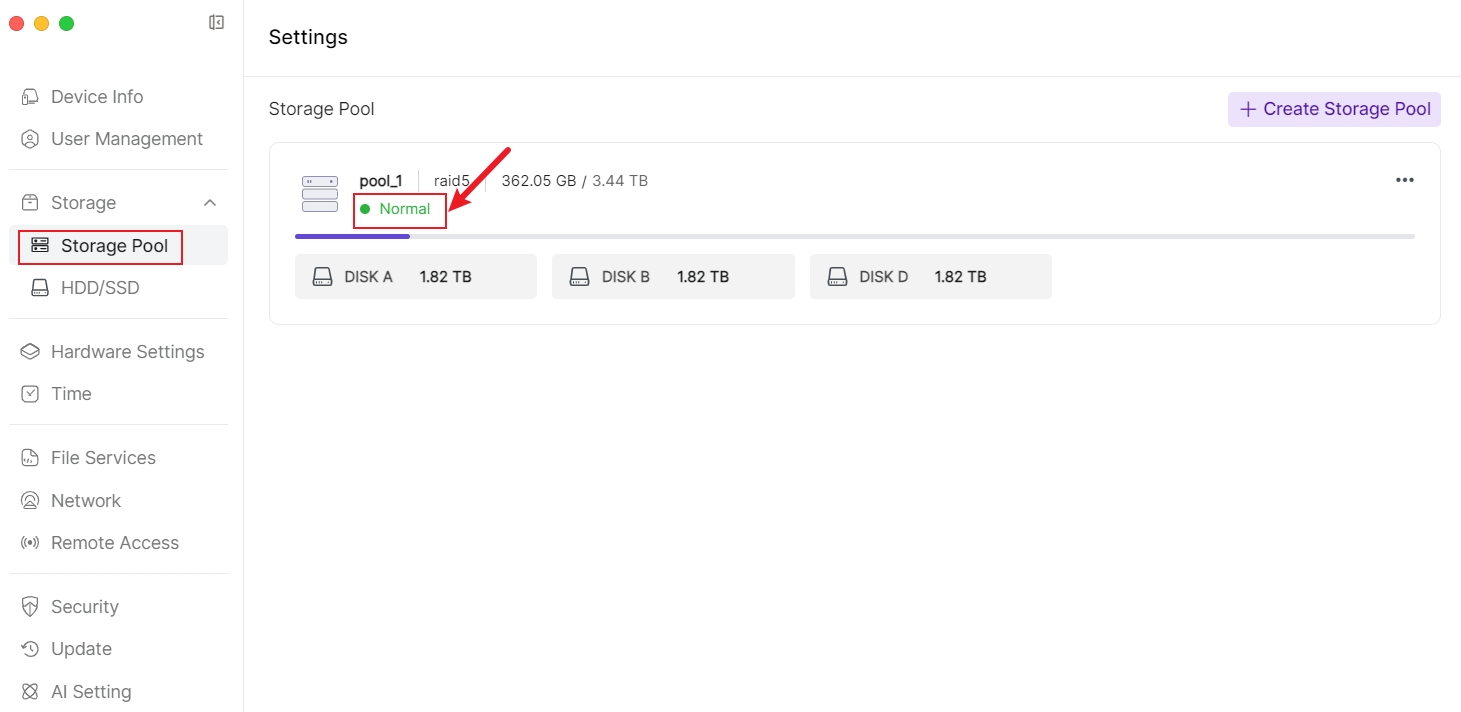Storage Status Description

Storage Status | Description |
|---|---|
| Normal | The mailbox and storage pool support normal read/write operations |
| Degraded | Some hard disks in the storage pool are damaged or removed, but the storage pool can still read and write normally |
| Destroyed | Some or all hard disks in the storage pool are damaged or removed, and the storage pool cannot read or write |
| Syncing | After creating RAID 1, RAID 5, RAID 6, or RAID 10, the status will be "syncing". If the system storage pool needs synchronization, it will be in "preparing" state first; after the system synchronization is completed, the user storage pool will be synchronized. When these RAID types are degraded and a new disk is inserted for repair, the status will be "syncing". Normal read/write operations are possible in this state |
| Repairing | After the storage pool enters a degraded state, it is in the process of being repaired by selecting disks; or some disks were removed and reinserted, entering repair mode |
| Rebuilding | The storage pool is being expanded or upgraded in RAID level, and the storage pool enters rebuilding state |
| Preparing | The system RAID is synchronizing |
RAID Storage Modes Explained
1. Basic (Single Disk Mode)
- Principle: Uses a single hard disk to store data, with no redundancy or striping.
- Advantages:
- Simple and easy to use, no complex configuration required.
- Low cost, suitable for small-scale storage needs.
- Disadvantages:
- No redundancy, hard drive failure will lead to data loss.
- Limited performance, cannot utilize multiple disks for parallel read/write operations.
- Applicable Scenarios: Personal users, small storage needs, or scenarios with low requirements for data security.
2. JBOD (Just a Bunch of Disks)
- Principle: Combines multiple hard disks into a single logical volume, data is stored sequentially, with no redundancy or striping.
- Advantages:
- Fully utilizes all hard disk capacity.
- Simple configuration, suitable for expanding storage space.
- Disadvantages:
- No redundancy, failure of any hard disk will lead to partial data loss.
- No performance improvement, cannot utilize multiple disks for parallel read/write operations.
- Applicable Scenarios: Scenarios requiring large-capacity storage with no requirements for performance and data redundancy.
3. RAID 0 (Striping)
- Principle: Data is divided into blocks and alternately stored on multiple hard disks.
- Advantages:
- Significantly improves read/write performance (parallel operations on multiple disks).
- High storage space utilization (no redundant data).
- Disadvantages:
- No redundancy, failure of any hard disk will lead to complete data loss.
- Applicable Scenarios: Scenarios with high performance requirements but low data security requirements, such as video editing, temporary caching.
4. RAID 1 (Mirroring)
- Principle: Data is completely copied to multiple hard disks, with each disk storing the same data.
- Advantages:
- High data security (when one hard disk fails, data can still be recovered from other disks).
- Improved read performance (can read from multiple disks simultaneously).
- Disadvantages:
- Low storage space utilization (for example, two hard disks can only use half of the capacity).
- No improvement in write performance (data needs to be written to multiple disks).
- Applicable Scenarios: Scenarios with high data security requirements, such as financial systems, databases.
5. RAID 5 (Striping with Parity)
- Principle: Data is divided into blocks and stored on multiple hard disks, while also storing parity information (for data recovery).
- Advantages:
- Balances performance and data security (allows for one hard disk failure).
- High storage space utilization (only loses the capacity of one disk for parity).
- Disadvantages:
- Lower write performance (requires parity calculation).
- Significant performance degradation during data reconstruction.
- Applicable Scenarios: Scenarios with moderate requirements for performance and security, such as file servers, small to medium-sized databases.
6. RAID 6 (Dual Parity Striping)
- Principle: Similar to RAID 5, but uses two sets of parity information, allowing for two simultaneous hard disk failures.
- Advantages:
- Higher data security (allows for two hard disk failures).
- Still relatively high storage space utilization (only loses the capacity of two disks for parity).
- Disadvantages:
- Even lower write performance (requires calculation of two sets of parity).
- More significant performance degradation during data reconstruction.
- Applicable Scenarios: Scenarios with extremely high data security requirements, such as large databases, critical business systems.
7. RAID 10 (Mirroring + Striping)
- Principle: Combines RAID 1 (mirroring) and RAID 0 (striping), first grouping disks for mirroring, then striping across the groups.
- Advantages:
- High performance (striping improves read/write speeds).
- High data security (allows for one hard disk failure in each mirror group).
- Disadvantages:
- Low storage space utilization (can only use half of the total capacity).
- Higher cost (requires at least 4 hard disks).
- Applicable Scenarios: Scenarios with extremely high requirements for both performance and data security, such as databases, virtualization platforms.